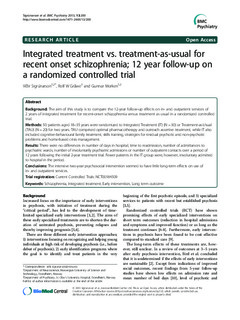| dc.contributor.author | Sigrunarson, Vidir | |
| dc.contributor.author | Gråwe, Rolf W. | |
| dc.contributor.author | Morken, Gunnar | |
| dc.date.accessioned | 2019-10-28T08:14:33Z | |
| dc.date.available | 2019-10-28T08:14:33Z | |
| dc.date.created | 2013-09-30T13:27:59Z | |
| dc.date.issued | 2013 | |
| dc.identifier.citation | BMC Psychiatry. 2013, 13 (200), . | nb_NO |
| dc.identifier.issn | 1471-244X | |
| dc.identifier.uri | http://hdl.handle.net/11250/2624773 | |
| dc.description.abstract | Background
The aim of this study is to compare the 12-year follow-up effects on in- and outpatient services of 2 years of integrated treatment for recent-onset schizophrenia versus treatment as usual in a randomized controlled trial.
Methods
50 patients aged 18–35 years were randomized to Integrated Treatment (IT) (N = 30) or Treatment-as-Usual (TAU) (N = 20) for two years. TAU comprised optimal pharmacotherapy and outreach assertive treatment, while IT also included cognitive-behavioural family treatment, skills training, strategies for residual psychotic and non-psychotic problems and home-based crisis management.
Results
There were no differences in number of days in hospital, time to readmission, number of admittances to psychiatric wards, number of involuntarily psychiatric admissions or number of outpatient contacts over a period of 12 years following the initial 2-year treatment trial. Fewer patients in the IT group were, however, involuntary admitted to hospital in the period.
Conclusions
The intensive two-year psychosocial intervention seemed to have little long-term effects on use of in- and outpatient services. | nb_NO |
| dc.language.iso | eng | nb_NO |
| dc.publisher | BMC (part of Springer Nature) | nb_NO |
| dc.relation.uri | http://hdl.handle.net/11250/264216 | |
| dc.rights | Navngivelse 4.0 Internasjonal | * |
| dc.rights.uri | http://creativecommons.org/licenses/by/4.0/deed.no | * |
| dc.title | Integrated treatment vs. treatment-as-usual for recent onset schizophrenia; 12 year follow-up on a randomized controlled trial | nb_NO |
| dc.type | Journal article | nb_NO |
| dc.type | Peer reviewed | nb_NO |
| dc.description.version | publishedVersion | nb_NO |
| dc.source.pagenumber | 8 | nb_NO |
| dc.source.volume | 13 | nb_NO |
| dc.source.journal | BMC Psychiatry | nb_NO |
| dc.source.issue | 200 | nb_NO |
| dc.identifier.doi | 10.1186/1471-244X-13-200 | |
| dc.identifier.cristin | 1053848 | |
| dc.description.localcode | © 2013 Sigrúnarson et al.; licensee BioMed Central Ltd. This is an Open Access article distributed under the terms of the Creative Commons Attribution License (http://creativecommons.org/licenses/by/2.0), which permits unrestricted use, distribution, and reproduction in any medium, provided the original work is properly cited. | nb_NO |
| cristin.unitcode | 1920,22,0,0 | |
| cristin.unitcode | 194,65,30,0 | |
| cristin.unitcode | 1920,30,0,0 | |
| cristin.unitcode | 194,65,35,0 | |
| cristin.unitcode | 1920,17,0,0 | |
| cristin.unitname | PH - Nidaros distriktspsykiatriske senter | |
| cristin.unitname | Institutt for nevromedisin og bevegelsesvitenskap | |
| cristin.unitname | Klinikk for rus- og avhengighetsmedisin | |
| cristin.unitname | Institutt for psykisk helse | |
| cristin.unitname | PH - Avdeling for forskning og utvikling | |
| cristin.ispublished | true | |
| cristin.fulltext | original | |
| cristin.qualitycode | 1 | |

